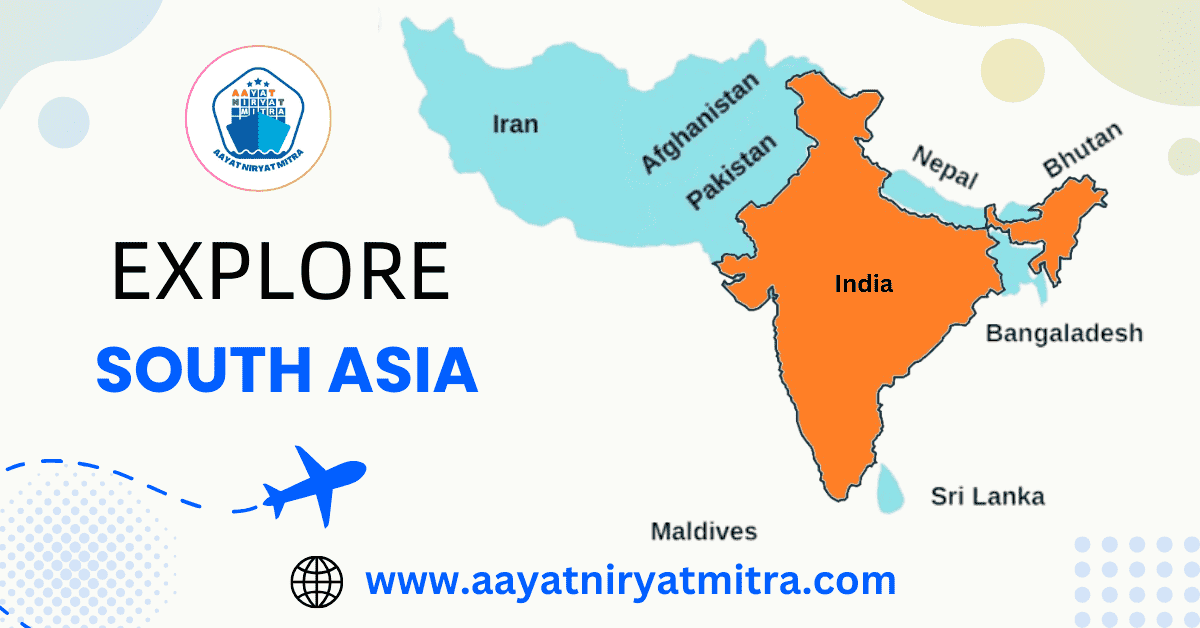India-South Asia Trade is on the brink of a trade revolution. This article explores the strategic importance of trade between India and South Asia in 2024, shedding light on the benefits of regional economic integration.
South Asia, a vibrant tapestry of nations, presents a lucrative market for Indian exporters. This region, geographically close and culturally connected, offers immense potential for boosting trade and fostering economic growth. To help Indian businesses navigate this exciting opportunity, this guide explores the import preferences of South Asian countries, strategies for success, and resources to empower your export journey.
Member of South Asian Countries:
- Afghanistan
- Bangladesh
- Bhutan
- Iran
- Maldives
- Nepal
- Pakistan
- Sri-Lanka
South Asian Countries and Their Indian Import Preferences:
- Afghanistan: Relies heavily on Indian imports for essential goods like pharmaceuticals, textiles, and machinery to rebuild its infrastructure.
- Bangladesh: A major importer of Indian cotton, yarn, and finished textiles, driven by its booming garment industry. Additionally, Bangladesh imports pharmaceuticals, vehicles, and electronics from India.
- Bhutan: Bhutan imports electrical machinery and equipment from India, focusing on hydropower development. Construction materials and essential commodities also find a strong market here.
- Iran: Despite political complexities, Iran remains an importer of Indian pharmaceuticals, tea, and rice.
- Maldives: Tourism is the lifeblood of the Maldives, making India a vital source of food products, construction materials, and consumer goods.
- Nepal: Nepal imports a wide range of products from India, including fuel, pharmaceuticals, vehicles, and agricultural products.
- Pakistan: While trade relations are complex, Pakistan imports some Indian products like pharmaceuticals and certain agricultural goods.
- Sri Lanka: Sri Lanka imports various goods from India, including pharmaceuticals, sugar, cotton, and machinery.
Strategies for Success in the South Asian Market:
- Market Research: Conduct thorough research to understand the specific import needs and regulations of each target country.
- Product Adaptation: Be prepared to adapt your products to meet local preferences, such as language labeling or packaging modifications.
- Building Relationships: Cultivate strong relationships with regional distributors and importers for efficient market access.
- Competitive Pricing: Price your products competitively, considering local market dynamics and potential duty structures.
Challenges and Solutions:
- Non-Tariff Barriers: Complex customs procedures and regulations can hinder smooth trade flow. Staying updated on regulations and working with experienced customs brokers can help navigate these challenges.
- Logistics: Infrastructure limitations can pose logistical hurdles. Explore alternative transportation routes and consider partnering with regional logistics companies for streamlined delivery.
- Political Tensions: Political complexities may arise in certain regions. Focus on building trust with local partners and staying informed about regional developments.
Resources for Indian Exporters:
- The Directorate General of Foreign Trade (DGFT): Provides vital information on trade policies, export procedures, and trade agreements with South Asian countries. DGFT
- Federation of Indian Export Organisations (FIEO): Offers resources, and training programs, and connects exporters with potential buyers in South Asia. FIEO
- Regional Trade Agreements (RTAs): Utilize existing RTAs like SAFTA (South Asian Free Trade Area) to benefit from reduced tariffs and streamlined trade procedures. SAFTA
Future Growth Opportunities:
- E-commerce Boom: The burgeoning e-commerce sector in South Asia presents an opportunity to reach a wider audience through online marketplaces.
- Focus on Renewables: As South Asia prioritizes renewable energy, India’s expertise in solar panels and wind turbines can be leveraged.
- Regional Integration: Increased regional cooperation can lead to improved infrastructure and a more unified market, boosting trade opportunities.
India-South Asian Trade: Advantages of Exporting to the Continent:
- Proximity and Cultural Affinity: Geographical closeness and cultural understanding create a natural advantage for Indian exporters.
- Favorable Trade Agreements: Existing trade agreements offer reduced tariffs and simplified trade procedures.
- Growing Economies: South Asia’s rapidly growing economies present a vast and expanding market for Indian goods.
Popular Indian Products in South Asian Countries:
- Pharmaceuticals
- Textiles and Garments
- Machinery and Equipment
- Food Products (Rice, Wheat, Sugar)
- Construction Materials
- Vehicles
| Commodity View | Total Exports Apr’23 – Mar’24 ($Mn) | % Share in selected criteria’s Total Exports |
|---|---|---|
| Engineering Goods | 6,181.99 | 23.07% |
| Petroleum Products | 5,044.08 | 18.82% |
| Others | 3,718.73 | 13.88% |
| Cotton Yarn/Fabs./Made-ups, Handloom Products Etc. | 2,529.55 | 9.44% |
| Organic and Inorganic Chemicals | 1,398.42 | 5.22% |
| Drugs And Pharmaceuticals | 1,170.55 | 4.37% |
| Rice | 923.89 | 3.45% |
| Oil Meals | 791.48 | 2.95% |
| Plastic And Linoleum | 702.37 | 2.62% |
| Fruits And Vegetables | 636.65 | 2.38% |
| Spices | 571 | 2.13% |
| Mica, Coal, And Other Ores, Minerals Including Process | 527.31 | 1.97% |
| Man-Made Yarn/Fabs./Madeups Etc. | 519.93 | 1.94% |
| Electronic Goods | 476.5 | 1.78% |
| Cereal Preparations And Miscellaneous Processed Item | 452.88 | 1.69% |
| Ceramic Products And Glassware | 226.23 | 0.84% |
| Other Cereals | 197.62 | 0.74% |
| Ready-made garments of all textiles | 180.93 | 0.68% |
| Meat, Dairy And Poultry Products | 120.55 | 0.45% |
| Marine Products | 86.65 | 0.32% |
| Oil Seeds | 67.5 | 0.25% |
| Gems And Jewellery | 67.01 | 0.25% |
| Tobacco | 50.79 | 0.19% |
| Tea | 44.79 | 0.17% |
| Leather And Leather Manufacturers | 37.75 | 0.14% |
| Handicrafts Excl. Hand Made Carpet | 34.52 | 0.13% |
| Coffee | 23.36 | 0.09% |
| Cashew | 11.51 | 0.04% |
| Iron Ore | 2.08 | 0.01% |
| Carpet | 1.73 | 0.01% |
| Jute Mfg. Including Floor Covering | 1.6 | 0.01% |
| Total | 26,799.95 | 100.00% |
FAQs on South Asian Countries Imports from India:
-
Q: What is the current state of trade between India and South Asia?
Ans: Trade between India and South Asia has been growing steadily, but there’s still significant room for improvement. The South Asian Free Trade Area (SAFTA) agreement provides some tariff reductions, yet non-tariff barriers and infrastructure limitations continue to hinder smooth trade flows.
-
Q: What are the major benefits of increased trade between India and South Asia?
Ans: Enhanced trade can drive economic growth, create jobs, attract investments, and foster regional innovation. It allows businesses to access broader markets and provides consumers with greater competition and a wider variety of products.
-
Q: What are some of the challenges faced in India-South Asia trade?
Ans: Complex customs procedures, non-tariff barriers, and limited infrastructure like transportation networks pose significant challenges. Additionally, varying regulations across countries create hurdles for businesses trying to operate in multiple South Asian markets.
-
Q: What role can India play in boosting South Asia’s trade?
Ans: As the region’s economic powerhouse, India can invest in regional infrastructure development, promote policy reforms for easier trade, and share its expertise with South Asian neighbors to enhance their competitiveness.
-
Q: What are some existing trade agreements between India and South Asian countries?
Ans: The South Asian Free Trade Area (SAFTA) agreement offers reduced tariffs on certain goods traded between member countries. However, further trade liberalization agreements are needed to achieve deeper economic integration.
-
Q: What are the future prospects of India-South Asia trade?
Ans: With a focus on infrastructure development, policy reforms promoting regional integration, and fostering collaboration, the future of India-South Asia trade looks promising. This can unlock immense economic potential for the entire region.
-
Q: How can businesses benefit from increased trade between India and South Asia?
Ans: Businesses can access a wider market base, reduce trade costs, and form new partnerships. This can lead to increased sales, market share growth, and diversification of product offerings.
-
Q: What are some specific examples of sectors that could benefit from stronger India-South Asia trade?
Ans: Sectors like textiles, pharmaceuticals, agriculture, and information technology hold immense potential for growth with enhanced regional trade.
-
Q: What role can technology play in facilitating India-South Asia trade?
Ans: Technological advancements can streamline trade processes, improve logistics, and foster cross-border communication. E-commerce platforms can also play a key role in expanding market reach for businesses.
-
Q: Where can I find more information on India-South Asia trade?
Ans: Resources from organizations like the World Bank, Asian Development Bank, and regional trade bodies offer valuable insights on India-South Asia trade trends, challenges, and opportunities.
Conclusion:
South Asia represents a fertile ground for Indian exporters. By understanding market needs, strategizing effectively, and utilizing available resources, Indian businesses can tap into this promising region and contribute to the collective prosperity of South Asia.
If you discover an error in the “South Asian Imports from India: A Guide for Indian Exporters in 2024“ information provided to us, please notify us immediately via the comment box and email; if the information provided by you is correct, We will change it.
If you enjoyed this article, please share it with your friends. Please visit Aayat Niryat Mitra | Import Export Friend for more information on this and other topics. Thank you for stopping by.

